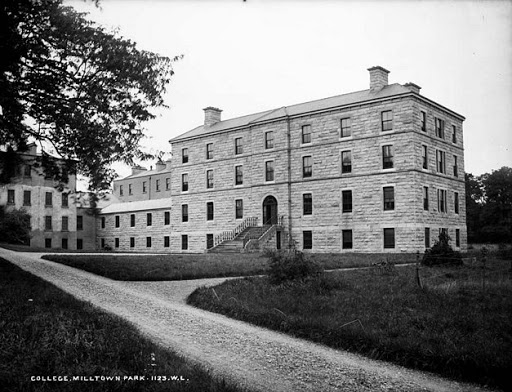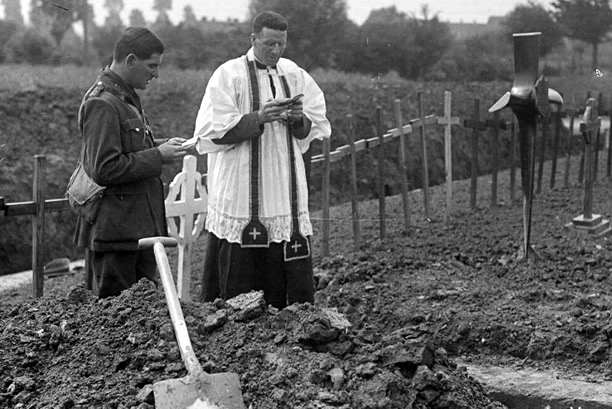Patrick Fitzgibbon - Life and Times

My grandfather Patrick Fitzgibbon served in the First World War, as an ambulance driver and I'm sure this is a picture of him behind the wheel, in a posed photo with a nurse and another colleague in the background.
I could be mistaken, but I also think he is in the front row of the second photo (second from the left) with a whole group of people posing behind a sign which says - "The Last Bus to Blighty".
I never got to talk to my grandfather about his wartime experiences, but I came across a post card dated 15 October 1919 from a friend in London which reads:
"Dear Pat
Am sure you will appreciate this pic of the statue erected to the memory of dear Fr Carey (RIP).
I have an idea that you wanted some other photos. If you let me know and I have them I will try and oblige you.
Yours sincerely
G Bunker
125 Torrans Avenue
Kentish Town
London"
I had a search on the internet and found out more about Father Timothy Carey who was originally from Limerick and served as a Chaplain in the British Army before he died from the secondary effects of the Spanish Flu in 1919.
The postcard to my grandfather shows Father Carey's grave and headstone in the churchyard at Audruicq near Calais.


So lockdown and the internet have opened up a window on my grandad's life which I knew nothing about up until now.
And if I'm ever in Calais again I'll be sure to visit Audruicq because the area clearly played an important part in my grandad's life and times.
https://burialsandbeyond.com/2020/05/01/collection-feature-rev-timothy-carey/
Collection Feature: Rev. Timothy Carey
The photograph of Timothy’s grave came to me in a large batch of photos, most of which were from the UK. However, one was grander than the others and clearly from overseas.
This week, with the help of some wonderful WWI archive websites, I hope to share a little of the life of the Reverend Timothy Carey.

Timothy Carey was born in 1878 to Patrick and Mary Carey of County Limerick. After joining the priesthood, Carey moved to Dublin to further his studies. In 1911, he was recorded as being fully literate and living at a residence at Sandford Road, Rathmines and Rathgar East, Dublin – a part of the Catholic college of Milltown Park. Living alongside Carey were 52 other Catholic Priests; while most were from Ireland, others were from as far afield as Australia, Belgium, Italy, Portugal, Mexico and Macau.

The College at Milton Park
Carey was an Irish Jesuit priest who trained in Dublin and found himself ministering to troops at the outbreak of WWI. Jesuit priests – priests of ‘The Society of Jesus’ – are a catholic religious order, characterised by an emphasis on public service and justice. The order remains a small, particularly evangelical, offshoot with around 16,000 serving members.
Timothy Carey trained as a priest at Milltown Park in Dublin. Milltown has had a Jesuit training centre in one form or another since the 1880s, when a school of Philosophy and Theology was established. Sadly, the Jesuit order had to close in 2015 and sold the last of their Milltown land and property in 2019.
The current Pope Francis stayed at Milltown for a short time in the 1980s, in order to improve his English. This was alongside his theological studies and teaching and was only for a few weeks, but was a brief claim to fame for the Milltown community! Pope Francis was also the first Jesuit to become Pope.

During the First World War, 32 Irish Jesuits served as chaplains in France, Belgium, Egypt and Mesopotamia. Four were killed and two died of illness. Additionally, 11 Irishmen served with the English Jesuit Province, of which two were killed – Frs. Walter Montague and Timothy Carey.
While many priests volunteered, some were put forward for the position, despite their reservations. For many young priests, fresh out of college, being sent into a warzone was their first experience of priesthood.
‘The majority of Jesuit chaplains served at the front line with the soldiers, with intervals at casualty clearing stations, field ambulances and hospitals…’[1]
‘The chaplain’s duties included giving the sacraments, saying Mass, burial, working as stretcher-bearers or medical attendants, and writing to relatives of those who were killed and keeping up morale.’

‘The most striking characteristic of this ministry was that the chaplains were alongside the troops and were exposed to the same dangers and threats. It was this apostolate of presence and proximity that won the admiration and respect of the soldiers.’[2]
Chaplains lived alongside the soldiers, sharing trenches and living conditions, forming close bonds with the soldiers. However, in late 1918 an Influenza Epidemic hit troops across Europe.
The Spanish Flu influenza pandemic lasted from January 1918 to December 1920. It claimed the lives of millions, with an estimated worldwide death toll of 17-50 million, with some speculations peaking at 100 million. To put the flu into perspective, it killed more people in 24 weeks than HIV/AIDS killed in 24 years. The Spanish Flu was a strain of the H1N1 virus, the same virus that caused the swine flu epidemic of 2009.
While influenza weakened the body, death was generally brought about by a secondary cause, such as pneumonia. Flu is most deadly to the young, elderly and infirm, yet the Spanish Flu epidemic was unusual in that 92% of deaths occurred in people under 65.
Carey was an Irish Jesuit priest who trained in Dublin and found himself ministering to troops at the outbreak of WWI. Jesuit priests – priests of ‘The Society of Jesus’ – are a catholic religious order, characterised by an emphasis on public service and justice. The order remains a small, particularly evangelical, offshoot with around 16,000 serving members.
Timothy Carey trained as a priest at Milltown Park in Dublin. Milltown has had a Jesuit training centre in one form or another since the 1880s, when a school of Philosophy and Theology was established. Sadly, the Jesuit order had to close in 2015 and sold the last of their Milltown land and property in 2019.
The current Pope Francis stayed at Milltown for a short time in the 1980s, in order to improve his English. This was alongside his theological studies and teaching and was only for a few weeks, but was a brief claim to fame for the Milltown community! Pope Francis was also the first Jesuit to become Pope.

During the First World War, 32 Irish Jesuits served as chaplains in France, Belgium, Egypt and Mesopotamia. Four were killed and two died of illness. Additionally, 11 Irishmen served with the English Jesuit Province, of which two were killed – Frs. Walter Montague and Timothy Carey.
While many priests volunteered, some were put forward for the position, despite their reservations. For many young priests, fresh out of college, being sent into a warzone was their first experience of priesthood.
‘The majority of Jesuit chaplains served at the front line with the soldiers, with intervals at casualty clearing stations, field ambulances and hospitals…’[1]
‘The chaplain’s duties included giving the sacraments, saying Mass, burial, working as stretcher-bearers or medical attendants, and writing to relatives of those who were killed and keeping up morale.’

‘The most striking characteristic of this ministry was that the chaplains were alongside the troops and were exposed to the same dangers and threats. It was this apostolate of presence and proximity that won the admiration and respect of the soldiers.’[2]
Chaplains lived alongside the soldiers, sharing trenches and living conditions, forming close bonds with the soldiers. However, in late 1918 an Influenza Epidemic hit troops across Europe.
The Spanish Flu influenza pandemic lasted from January 1918 to December 1920. It claimed the lives of millions, with an estimated worldwide death toll of 17-50 million, with some speculations peaking at 100 million. To put the flu into perspective, it killed more people in 24 weeks than HIV/AIDS killed in 24 years. The Spanish Flu was a strain of the H1N1 virus, the same virus that caused the swine flu epidemic of 2009.
While influenza weakened the body, death was generally brought about by a secondary cause, such as pneumonia. Flu is most deadly to the young, elderly and infirm, yet the Spanish Flu epidemic was unusual in that 92% of deaths occurred in people under 65.


Timothy Carey was registered as a Chaplain 4th Class and was posted to a British camp at Calais. Despite surviving two years in a warzone, he would never return home to Ireland.
‘Fr Patrick Morris SJ, who worked at the Clipstone Camp in Mansfield, Nottinghamshire, comments: “What havoc the influenza has brought… We had a bad time in camp here… [T]hree of my boys died, but they were well prepared”. He caught the flu himself but “went to bed immediately and nipped it in the bud”. Fr Timothy Carey SJ, of the British Province, would die from the effects of influenza in February 1919, at Calais, France.’[3]
After contracting influenza, Carey was admitted to no.35 General Hospital (a field hospital) in Calais where he died shortly afterwards. Aged 41, he was buried at the west end of the churchyard at Audruicq near Calais.
In the same churchyard extension sit the graves of 6 other British (serving under British battalions etc) soldiers, one of which has never been identified.
 ww1cemeteries.com
ww1cemeteries.com
ww1cemeteries.com
Timothy clearly was of great importance to his men and memorial postcards of his grave were produced after his burial. The importance of spiritual and emotional support in such horrific circumstances can never be overstated.
“Of your charity pray for the repose of the soul of Rev. Fr. Timothy Carey S. J. C. F., who died at Calais on the 27th February 1919, aged 41. This monument erected by British soldiers and parishioners of Audruicq is a token of love and esteem for one who served with conspicuous zeal for 2 years at Audruicq as their beloved chaplain and priest.”

Sources/Further Reading:
https://www.ww2cemeteries.com/audruicq-churchyard-and-extension.html
http://www.theygavetheirtoday.com/the-army-chaplains.html
http://www.census.nationalarchives.ie/pages/1901/Dublin/Rathmines___Rathgar_East/Milltown__Part_of_Sandford_Road_/
https://www.ww1cemeteries.com/audruicq-churchyard-and-extension.html
https://www.jesuit.ie/blog/damien-burke/the-last-parting-jesuits-and-armistice/
[1](JSTOR)
[2]Studies. Vol 104. No 414.
[3]https://www.jesuit.ie/blog/damien-burke/the-last-parting-jesuits-and-armistice/
Timothy clearly was of great importance to his men and memorial postcards of his grave were produced after his burial. The importance of spiritual and emotional support in such horrific circumstances can never be overstated.
“Of your charity pray for the repose of the soul of Rev. Fr. Timothy Carey S. J. C. F., who died at Calais on the 27th February 1919, aged 41. This monument erected by British soldiers and parishioners of Audruicq is a token of love and esteem for one who served with conspicuous zeal for 2 years at Audruicq as their beloved chaplain and priest.”

Sources/Further Reading:
https://www.ww2cemeteries.com/audruicq-churchyard-and-extension.html
http://www.theygavetheirtoday.com/the-army-chaplains.html
http://www.census.nationalarchives.ie/pages/1901/Dublin/Rathmines___Rathgar_East/Milltown__Part_of_Sandford_Road_/
https://www.ww1cemeteries.com/audruicq-churchyard-and-extension.html
https://www.jesuit.ie/blog/damien-burke/the-last-parting-jesuits-and-armistice/
[1](JSTOR)
[2]Studies. Vol 104. No 414.
[3]https://www.jesuit.ie/blog/damien-burke/the-last-parting-jesuits-and-armistice/

